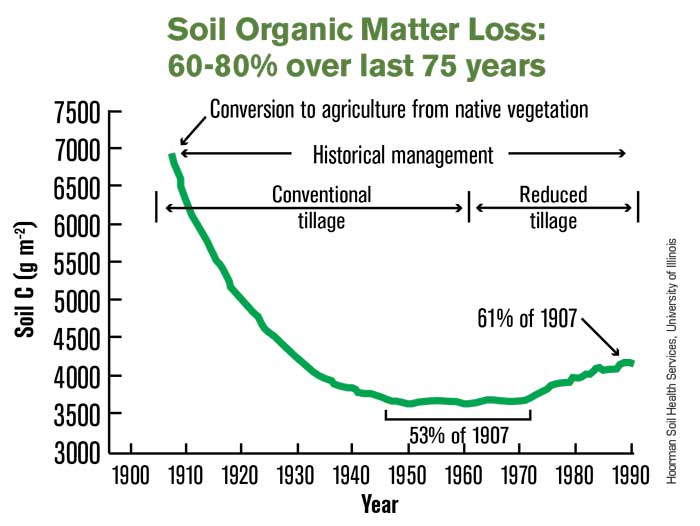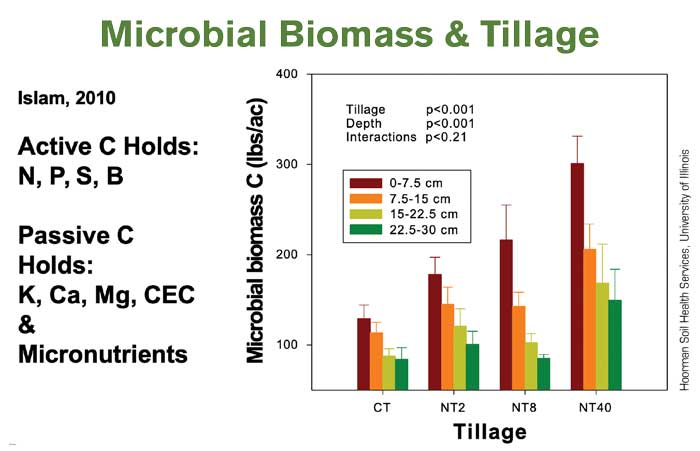Soil has lost 60-80% of its organic matter in the last 75-100 years, according to a 2010 University of Illinois study and research done by Ohio State Researcher, Dr. Rattan Lal. But conservation tillage methods like strip-till are jumpstarting an organic matter resurgence, according to Jim Hoorman, soil health scientist at Hoorman Soil Health Services in Jenera, Ohio. In addition to conservation tillage methods, the soil health scientist says the key to healthy soils is making sure there are living roots in the ground year-round. “Live roots are what it’s all about,” Hoorman says. “You must have live roots in the soil to increase your fertility. That will make the soil’s nutrients available.”
"Every one of those microbes is a soluble bag of fertilizer..."
Feed the Microbes
“Almost all the soil’s nutrients go through microbes before reaching the plant,” Hoorman says. “Microbes need to be fed.” Most soil microbes include fungi, bacteria, archaea, protozoa and viruses, according to soil health experts at Penn State University. Beneficial soil microbes carry out important functions, such as cycling nutrients, breaking down crop residues and stimulating plant growth.
Proper microbial management combined with a healthy microbial community — which includes earthworms, insects and plant roots — not only achieves more holistic practices, such as minimal ground disturbance from strip-tilling, but it can also increase the profitability of a crop.
Microbes process 90% of the energy in soil where live plants already grow, meaning with proper management practices, you could have 1,000-2,000 times more microbes, Hoorman says. “Every one of those microbes is a soluble bag of fertilizer,” he says. “I often ask, ‘Why are we fertilizing the corn and the soybeans when we should be fertilizing the microbes?’ After all, they’re the ones doing all the work.”
In Hoorman’s eyes, it’s as simple as that — if you want to reduce your fertilizer, you need to increase your soil’s microbes. And that can be achieved through the inclusion of consistent live roots in your fields as well as proper microbial and microbial community management.

COMEBACK OF THE CENTURY. Over the last 75 years, soil organic matter has decreased by 60-80% according to the University of Illinois. But that soil content is starting to return thanks to reduced tillage and diversified crop rotations.
Rotation Affects Microbes
The addition of a cover crop to a corn-soybean rotation could be a game changer for strip-tillers, Hoorman says. “Why not put another crop out there and have it growing?” he says. “Even if you’re not making money off that third crop, you’re investing in your soil’s fertility, in the microbes that are producing better soil for the following year. You are also restoring the carbon needed to increase photosynthesis to increase crop yields.”
Hoorman points out that most crops will give anywhere from 20-45% of their total carbohydrates to feed microbes because those microbes then feed the plant. It’s a team effort. Not only can plants absorb nitrogen, nitrate and ammonium, but they can also collect amino acids and full proteins from bacteria through the tips of their growing roots. This process is called rhizophagy.
To do this, the bacteria lose their cell wall, and the roots absorb these elements inside the plant cells. The bacteria replicate themselves quickly in the plant cells. When the population gets too high, they push out on the root, forming root hairs. The bacteria without cell walls are ejected into the soil, grow new cell walls and gain nutrients, then may be reabsorbed by the plant roots again. The whole process takes about 2 days.
“Typically, 10% of the bacteria don’t make it back into the soil,” Hoorman says. “But that’s OK because they give the plant growth hormones when they decompose inside the plant root, making those roots proliferate and increase plant growth.
“It’s important to have a lot of diversity in the different crops you grow. In turn, you have a wide diversity of microbes.” Hoorman says the worst crop rotation strategy is one that features only a single annual crop. “All corn isn’t as bad as all soybeans,” he says. “With only soybeans, we generally see yields get worse and worse. “I know some farmers who produce soybeans after soybeans after soybeans,” he says. “But they’ll rotate — soybeans, cereal rye, soybeans, barley and then back to soybeans. This helps break up pest and disease cycles, ensuring that no one microbe becomes dominant, which can promote disease. It’s similar to a soybean-corn rotation.”

HUNGRY MICROBES. Research shows that less tillage increases the total amount of microbial biomass in the top 30 centimeters of the soil. This chart shows how 40 years of no-till (NT40) resulted in more microbial biomass than conventional tillage (CT).
Cover Crops Prevent Erosion & Increase Moisture
Erosion can be an issue with strip-till, especially on slopes and hillsides, according to Hoorman. “You definitely want to go around the hill rather than up and down, if at all possible,” he says. “But let’s face it — a lot of our fields just don’t lay out very well.”
Cover crops are a potential solution to the erosion problem because they act as a protective barrier against heavy rainfall, which can cause extreme runoff on sloping fields, Hoorman says. Unhealthy soils often have a higher surface tension, making it harder for water to penetrate deep into the soil. Excessive rain on heavily tilled or unhealthy soils can cause macropores to seal over, which decreases absorption, causing runoff and erosion.
“Good soil that has good structure can absorb more rain and keep it there,” Hoorman says. That increased absorption also makes for an ideal microbial environment. “Microbes and your microbial community like warmer soils and adequate temperatures protected by crop residue,” Hoorman says. “Earthworms like 80-degree temperatures and about 70-80% moisture, which is also ideal for most of our microbes. “One of the ways you can temper soil organic matter is with a buffer,” he adds. A healthy cover crop will provide a layer of protection and insulation, retaining a more consistent temperature and holding moisture in the soil. You’ll have much healthier microbes.”
Hoorman also states there are around 12 species of microbes that encourage efficient rainfall. During evapotranspiration, bacteria called pseudomonas on leaves can be transported into the atmosphere where water will freeze and come down as precipitation (rain, snow, sleet, hail). “If we get enough farmers planting live crops, we won’t have as many torrential rains as we used to because microbes in the atmosphere will help regulate rainfall.”






